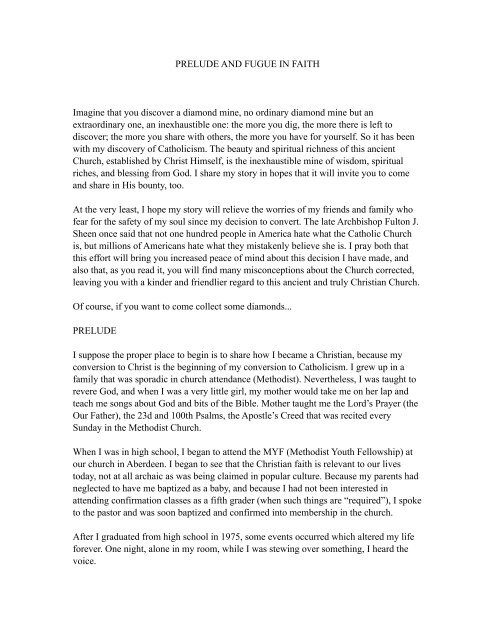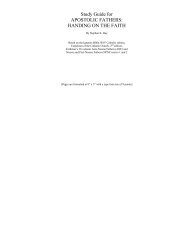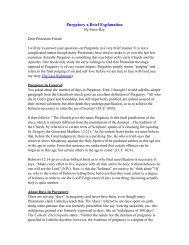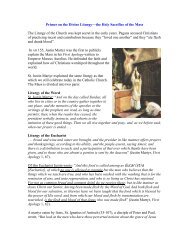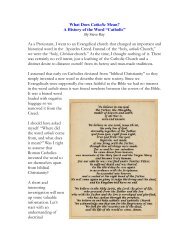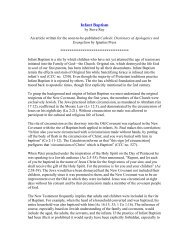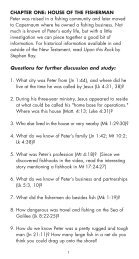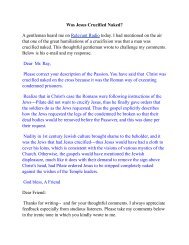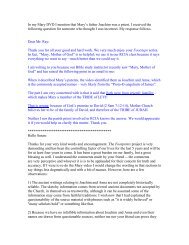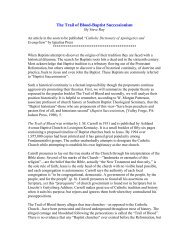Laura's Story Prelude to Fugue - Defenders of the Catholic Faith
Laura's Story Prelude to Fugue - Defenders of the Catholic Faith
Laura's Story Prelude to Fugue - Defenders of the Catholic Faith
Create successful ePaper yourself
Turn your PDF publications into a flip-book with our unique Google optimized e-Paper software.
PRELUDE AND FUGUE IN FAITHImagine that you discover a diamond mine, no ordinary diamond mine but anextraordinary one, an inexhaustible one: <strong>the</strong> more you dig, <strong>the</strong> more <strong>the</strong>re is left <strong>to</strong>discover; <strong>the</strong> more you share with o<strong>the</strong>rs, <strong>the</strong> more you have for yourself. So it has beenwith my discovery <strong>of</strong> <strong>Catholic</strong>ism. The beauty and spiritual richness <strong>of</strong> this ancientChurch, established by Christ Himself, is <strong>the</strong> inexhaustible mine <strong>of</strong> wisdom, spiritualriches, and blessing from God. I share my s<strong>to</strong>ry in hopes that it will invite you <strong>to</strong> comeand share in His bounty, <strong>to</strong>o.At <strong>the</strong> very least, I hope my s<strong>to</strong>ry will relieve <strong>the</strong> worries <strong>of</strong> my friends and family wh<strong>of</strong>ear for <strong>the</strong> safety <strong>of</strong> my soul since my decision <strong>to</strong> convert. The late Archbishop Ful<strong>to</strong>n J.Sheen once said that not one hundred people in America hate what <strong>the</strong> <strong>Catholic</strong> Churchis, but millions <strong>of</strong> Americans hate what <strong>the</strong>y mistakenly believe she is. I pray both thatthis effort will bring you increased peace <strong>of</strong> mind about this decision I have made, andalso that, as you read it, you will find many misconceptions about <strong>the</strong> Church corrected,leaving you with a kinder and friendlier regard <strong>to</strong> this ancient and truly Christian Church.Of course, if you want <strong>to</strong> come collect some diamonds...PRELUDEI suppose <strong>the</strong> proper place <strong>to</strong> begin is <strong>to</strong> share how I became a Christian, because myconversion <strong>to</strong> Christ is <strong>the</strong> beginning <strong>of</strong> my conversion <strong>to</strong> <strong>Catholic</strong>ism. I grew up in afamily that was sporadic in church attendance (Methodist). Never<strong>the</strong>less, I was taught <strong>to</strong>revere God, and when I was a very little girl, my mo<strong>the</strong>r would take me on her lap andteach me songs about God and bits <strong>of</strong> <strong>the</strong> Bible. Mo<strong>the</strong>r taught me <strong>the</strong> Lord’s Prayer (<strong>the</strong>Our Fa<strong>the</strong>r), <strong>the</strong> 23d and 100th Psalms, <strong>the</strong> Apostle’s Creed that was recited everySunday in <strong>the</strong> Methodist Church.When I was in high school, I began <strong>to</strong> attend <strong>the</strong> MYF (Methodist Youth Fellowship) a<strong>to</strong>ur church in Aberdeen. I began <strong>to</strong> see that <strong>the</strong> Christian faith is relevant <strong>to</strong> our lives<strong>to</strong>day, not at all archaic as was being claimed in popular culture. Because my parents hadneglected <strong>to</strong> have me baptized as a baby, and because I had not been interested inattending confirmation classes as a fifth grader (when such things are “required”), I spoke<strong>to</strong> <strong>the</strong> pas<strong>to</strong>r and was soon baptized and confirmed in<strong>to</strong> membership in <strong>the</strong> church.After I graduated from high school in 1975, some events occurred which altered my lifeforever. One night, alone in my room, while I was stewing over something, I heard <strong>the</strong>voice.
“Before <strong>the</strong> beginning.”I knew I was alone in my bedroom, but I sat up from my bed and looked around <strong>the</strong>room, anyway. The voice seemed very close.“Before <strong>the</strong> beginning.” Well... I knew enough <strong>of</strong> <strong>the</strong> Bible <strong>to</strong> recognize “<strong>the</strong> beginning:”“In <strong>the</strong> beginning God created <strong>the</strong> heavens and <strong>the</strong> earth...” (Gen. 1:1), and “In <strong>the</strong>beginning was <strong>the</strong> Word....” (John 1:1)“Before <strong>the</strong> beginning – “ <strong>the</strong> Voice again – “I knew you.”And I saw – I cannot tell you whe<strong>the</strong>r it was an image given <strong>to</strong> my imagination orsomething more physical, I can only tell you I saw – two figures in very bright light,looking down a corridor in<strong>to</strong> a room – a room with dingy green walls, an antique fourposterbed, and a teenage girl crying on <strong>the</strong> bed. My room. And me in it. I was given <strong>to</strong>understand that <strong>the</strong> corridor signified Time, and that <strong>the</strong> two figures I could distinguishwere Fa<strong>the</strong>r and Son; <strong>the</strong> brightness surrounding <strong>the</strong>m was <strong>to</strong> signify <strong>the</strong> Holy Spirit. Oneturned <strong>to</strong> <strong>the</strong> o<strong>the</strong>r and said, “I’ll take care <strong>of</strong> it.”And <strong>the</strong>n I saw Christ on <strong>the</strong> Cross. You must understand that at that time, my solefamiliarity with <strong>the</strong> appearance <strong>of</strong> <strong>the</strong> Crucifixion was from classical art representations Ihad seen in books and in <strong>the</strong> museum on a school <strong>to</strong>ur. Very clean, very sterile. Verypolite.But <strong>the</strong> Jesus I saw on that cross – from His chest up – was beaten <strong>to</strong> a bloody pulp. Nopart <strong>of</strong> His body that I could see was without <strong>the</strong> varied discolorations <strong>of</strong> bruising, fromyellow <strong>to</strong> angry purple. There were cuts and scratches and deep lacerations – even placeswhere part <strong>of</strong> His flesh gapped open in deep angry holes, skin and muscle hanging loosefrom His shoulders. His hair and beard were matted with blood and gore. The crown <strong>of</strong>thorns was larger than anything I had ever seen in any painting – before or since – and <strong>the</strong>inner spikes <strong>of</strong> <strong>the</strong> crown were gouged deeply in<strong>to</strong> <strong>the</strong> flesh <strong>of</strong> His forehead, creating stillmore deep lacerations.I was horrified. Only years later I would hear <strong>of</strong> <strong>the</strong> nature <strong>of</strong> Roman scourging, <strong>of</strong> <strong>the</strong> ca<strong>to</strong>’ nine tails with <strong>the</strong> bits <strong>of</strong> nails and metal that would catch an gash and tear a man’sflesh open from his body. Only years later I would find <strong>the</strong> verse in Isaiah 52, <strong>the</strong> chapterbefore <strong>the</strong> better-known “suffering servant” passage, which states that He would be“marred beyond <strong>the</strong> appearance <strong>of</strong> a man” (v. 14). But that night, I saw with my own eyes<strong>the</strong> naked reality <strong>of</strong> Christ’s Passion.He lifted His head and looked at me, and He said, “Swee<strong>the</strong>art, don’t you understand? Ifyou had been <strong>the</strong> only person in all <strong>of</strong> human his<strong>to</strong>ry who needed <strong>to</strong> be reconciled <strong>to</strong> <strong>the</strong>Fa<strong>the</strong>r, I would have done all this... just for you.”
strongest spiritual or emotional support, but ra<strong>the</strong>r from <strong>the</strong> academic community atGuilford College, where I was working on my bachelor’s degree. The gentle but strongQuaker influence over <strong>the</strong> campus allowed me a lot <strong>of</strong> room <strong>to</strong> go through <strong>the</strong> faith crisisthat was inevitable with <strong>the</strong> end <strong>of</strong> my marriage.I had been taught, indoctrinated, from my earliest days as a Christian, that if one “plays<strong>the</strong> game right” – if one attends church, reads <strong>the</strong> Bible studiously, prays, gives <strong>to</strong> <strong>the</strong>Church, abstains from all immoral practices – if one has enough faith – <strong>the</strong>n God willperform miracles and bad things will not happen <strong>to</strong> <strong>the</strong> faithful believer. But I had played<strong>the</strong> game right, and Dan had still left me. Suddenly, a lot <strong>of</strong> <strong>the</strong> things I had been taught Ihad <strong>to</strong> believe as a Christian – and I confess, that I had obnoxiously passed on <strong>to</strong> o<strong>the</strong>rpeople as well – were invalidated. They didn’t hold water. The surface upon which myreligious life had been built for more than a decade shattered.If it hadn’t been for <strong>the</strong> still-vivid memory <strong>of</strong> <strong>the</strong> vision <strong>of</strong> Christ on <strong>the</strong> Cross, thatpr<strong>of</strong>ound revelation <strong>of</strong> God’s love for me, I believe I would have done what a lot <strong>of</strong> o<strong>the</strong>rseverely disappointed Christians do in an unanticipated crisis and abandoned Christianityal<strong>to</strong>ge<strong>the</strong>r. But somehow <strong>the</strong> memory <strong>of</strong> that vision assured me that God’s love for mewas real, even if His ways had been misrepresented <strong>to</strong> me through human religiousinstitutions.The Quakers gave me plenty <strong>of</strong> room <strong>to</strong> sort out <strong>the</strong> mess. Theirs is simultaneously amystical yet bold confidence in God’s ability – and desire – <strong>to</strong> lead His people <strong>to</strong>Himself. I felt as if I had <strong>to</strong> start all over again as a Christian, from <strong>the</strong> basic reality <strong>of</strong>“Jesus Christ, Son <strong>of</strong> God, Savior” and discover anew what it means <strong>to</strong> be a Christian.This did not frighten <strong>the</strong> Quakers as it did <strong>the</strong> evangelicals; ra<strong>the</strong>r, it excited those withwhom I shared my thoughts on <strong>the</strong> matter.It was while I was a Quaker that I began working for an at<strong>to</strong>rney in Greensboro whom Ihad met while we both served as volunteers for a local pro-life ministry. Jim was amember <strong>of</strong> a large, upscale Methodist Church in down<strong>to</strong>wn Greensboro... but he was alsoa great admirer <strong>of</strong> <strong>the</strong> <strong>Catholic</strong> Church who attended Mass regularly, prayed <strong>the</strong> rosary,and read <strong>Catholic</strong> writers by <strong>the</strong> truckloads. His enthusiasm for <strong>the</strong> Church intrigued me.My first memories <strong>of</strong> exposure <strong>to</strong> <strong>the</strong> Church were as a child. The movie The Sound <strong>of</strong>Music comes immediately <strong>to</strong> mind. I thought it was wonderful that someone could choose<strong>to</strong> live life fully for God. Later I read Maria von Trapp’s au<strong>to</strong>biography, and I realizedthat her <strong>Catholic</strong> Christian faith was a much more vibrant part <strong>of</strong> her personal and familylife than <strong>the</strong> movie had portrayed. Of course, as I grew older and began hearing thingsabout <strong>the</strong> <strong>Catholic</strong> Church, its superstitions and oppressive rules and regulations, I thoughit was a pity that such devotion was tragically wasted on such an institutionI have never believed that <strong>the</strong> <strong>Catholic</strong> Church was <strong>the</strong> “whore <strong>of</strong> Babylon” like so many
fundamentalists have taught. I did believe some <strong>of</strong> <strong>the</strong> things I heard: that <strong>Catholic</strong>sworshipped Mary, that <strong>the</strong>y unquestioningly followed <strong>the</strong> Pope and even worshiped him;that <strong>the</strong>y had superstitions about praying <strong>to</strong> dead people, that <strong>the</strong>y didn’t believe Jesus’sufferings and death were adequate <strong>to</strong> save o<strong>the</strong>rs but needed “help” from sufferingChristians, that married people could only have sex <strong>to</strong> make a baby and were paranoidabout sex in all cases ... but I didn’t think <strong>Catholic</strong>s were bad people, just misguided andtrapped in bad teaching.And I’d even read some <strong>of</strong> <strong>the</strong> <strong>Catholic</strong> fa<strong>the</strong>rs in college, in a His<strong>to</strong>ry <strong>of</strong> Christianitycourse. Frankly, I hadn’t seen <strong>the</strong> pertinence <strong>of</strong> <strong>the</strong>m. I wasn’t mature enough as a studen<strong>to</strong>r as a Christian <strong>to</strong> appreciate what important works I was being exposed <strong>to</strong>; I hadwanted <strong>to</strong> get dates, a time line <strong>of</strong> crucial developments in <strong>the</strong> physical structure <strong>of</strong> <strong>the</strong>church, not read a bunch <strong>of</strong> dense ideas by people I’d never heard <strong>of</strong>, people likeIrenaeus, Tertullian, Origin... Thomas Aquinas. I did enjoy Augustine’s Confessions, atext appreciated by Christians <strong>of</strong> all denominations. But most <strong>of</strong> <strong>the</strong> Church fa<strong>the</strong>rs weresleepers, by my reckoning. Dead, outdated, outmoded... <strong>to</strong>tally irrelevant <strong>to</strong>contemporary church life. If <strong>the</strong>y weren’t, we’d hear a lot more about <strong>the</strong>m in <strong>the</strong> modernpulpit, wouldn’t we? Well, wouldn’t we? And I was content with that attitude.But <strong>the</strong>n I found a pamphlet. A fellow named John Barger, just five months after <strong>the</strong>death <strong>of</strong> his wife, Susan, had given a talk <strong>to</strong> a men’s group about what it means <strong>to</strong> be ahusband. “Do You Love Me?” had been reproduced in pamphlet form, and one day at <strong>the</strong><strong>of</strong>fice, I picked up a copy from Jim’s desk and sat down <strong>to</strong> read. I had tears in my eyeswhen I finished: here was a man who unders<strong>to</strong>od, who reaffirmed and validated,everything I had longed for in my marriage with Danny – ideals <strong>of</strong> heart-companionshipand partnership – everything was laid out in black and white, right <strong>the</strong>re in that pamphlet.Something stirred in my heart. I knew <strong>Catholic</strong>s were consistently faithful in <strong>the</strong>ir pro-lifetestimony, even though <strong>the</strong> mainstream Protestants were becoming increasingly accepting<strong>of</strong> abortion, <strong>of</strong> homosexuality, sexual license in all forms as well. I realized that <strong>the</strong><strong>Catholic</strong> Church was <strong>the</strong> only large Christian group that had consistently held on <strong>to</strong> <strong>the</strong>old moral values. And I respected that. Admired it. And now, through this little pamphle<strong>to</strong>f John Barger’s. I began <strong>to</strong> be aware <strong>of</strong> <strong>the</strong> great idealism with which <strong>the</strong> family ishonored by <strong>the</strong> Church – and <strong>of</strong> <strong>the</strong> <strong>Catholic</strong>ity <strong>of</strong> <strong>the</strong> ideal I’d thought unique <strong>to</strong>Quakerism: <strong>the</strong> sacramental quality <strong>of</strong> all <strong>of</strong> life.FUGUEOne day, in early 1996, not long before I moved back <strong>to</strong> <strong>the</strong> farm, a situation arose in <strong>the</strong>middle <strong>of</strong> <strong>the</strong> week that left me feeling a very strong need <strong>to</strong> go sit in a church and pray.Well, <strong>the</strong> only act in <strong>to</strong>wn during <strong>the</strong> week is <strong>the</strong> <strong>Catholic</strong> Church’s daily mass. I knewthat Jim sometimes went <strong>to</strong> mass before coming in <strong>to</strong> <strong>the</strong> <strong>of</strong>fice, so I called <strong>the</strong> parish heattended and got <strong>the</strong> schedule. Then I called him, <strong>to</strong>ld him, I’d be late <strong>to</strong> work <strong>the</strong> next
morning, and where I was going. He got excited, he <strong>to</strong>ld me “You’re going <strong>to</strong> love it Ijust know you are ”I got <strong>to</strong> <strong>the</strong> church a little before 7:30 <strong>the</strong> next morning. I had been inside Our Lady <strong>of</strong>Grace church once before, during a choral performance my older daughter had beeninvolved in. But this felt different. Somehow I hadn’t really seen <strong>the</strong> church <strong>the</strong>n. Thistime, I pushed open <strong>the</strong> heavy oak doors and walked in<strong>to</strong> <strong>the</strong> sanctuary and – I froze. For<strong>the</strong> first time I was aware <strong>of</strong> <strong>the</strong> splendid architecture, <strong>the</strong> vaulted ceilings, <strong>the</strong> stainedglass, <strong>the</strong> white marble altar area. For years and years, I’d been in Baptist churches,Christian and Missionary Alliance churches, Friends meetinghouses, all plain, and <strong>the</strong>Friends’ completely unadorned. This, <strong>the</strong>n, was splendor, this was magnificence – andevery bit <strong>of</strong> it pointed, not <strong>to</strong> <strong>the</strong> human designer but far beyond. A voice inside meproclaimed, “Behold <strong>the</strong> majesty and glory <strong>of</strong> Almighty God ”I s<strong>to</strong>od for several minutes before taking my seat in <strong>the</strong> back pew, and even <strong>the</strong>n Icontinued looking around in curiosity and awe. I watched several people enter, genuflectand cross <strong>the</strong>mselves before entering a pew, <strong>the</strong>n move forward <strong>to</strong> kneel on one <strong>of</strong> <strong>the</strong>drop-down kneelers <strong>to</strong> pray before <strong>the</strong> service began. It was a demonstration <strong>of</strong> devotionI found strangely moving. I noticed carvings along <strong>the</strong> outer walls <strong>of</strong> <strong>the</strong> sanctuary – fromliterary allusions I’d encountered in college, I recognized <strong>the</strong>m as <strong>the</strong> Stations <strong>of</strong> <strong>the</strong>Cross, a beautiful meditation and prayer on <strong>the</strong> sufferings <strong>of</strong> Christ. I saw statues. I saw<strong>the</strong> stained glass windows depicting <strong>the</strong> Life <strong>of</strong> Christ. My eye was regularly drawn <strong>to</strong> <strong>the</strong>white marble altar area up front, with all its splendid fixtures.Particularly, my attention was riveted <strong>to</strong> a “gold box” in <strong>the</strong> front <strong>of</strong> <strong>the</strong> sanctuary. Ididn’t know what it was, I didn’t know what it was called or anything about it. But Icouldn’t take my eyes <strong>of</strong>f that gold box. I knew, viscerally, by revelation, that my Lordand my God was in that box. I was electrified. And I knew just as surely that it was in <strong>the</strong>Communion Host, which until that moment I had thought was just one <strong>of</strong> many <strong>Catholic</strong>superstitions, that He was Present. The very word “Eucharist ” popped in<strong>to</strong> my mind asclearly and succinctly as if someone had whispered it in my ear.The mass itself is hardly memorable. All I could think was, He’s really <strong>the</strong>re And Ooh,how gross! Because literal meant... well, literal. Like cannibalism. But I couldn’t escapeit or ignore it: He was really <strong>the</strong>re, in <strong>the</strong> Eucharist. I knew it. I didn’t know how <strong>to</strong>reconcile it with my prejudices or sensibilities, but I decided that day that if <strong>the</strong> Churchwas right about that one crucial point – and she must be – <strong>the</strong>n if she were wrong abouteverything else, it wouldn’t really matter. I was going <strong>to</strong> have <strong>to</strong> become <strong>Catholic</strong>.A couple weeks later I was able <strong>to</strong> speak with <strong>the</strong> direc<strong>to</strong>r <strong>of</strong> religious education for thatparish, a man who was also a convert and an acquaintance through our daughters. Helaughed at my question about <strong>Catholic</strong>s being cannibals. Evidently lots <strong>of</strong> people think it,but most are <strong>to</strong>o polite <strong>to</strong> say anything about it. Not me
He explained that <strong>the</strong> term Transubstantiation dates back <strong>to</strong> <strong>the</strong> time <strong>of</strong> Thomas Aquinas,whom I remembered from my His<strong>to</strong>ry <strong>of</strong> Christianity class at Guilford. Then it clickedfor me.Essentially, according <strong>to</strong> Aris<strong>to</strong>tle, whose philosophical work was a major source forAquinas as he under<strong>to</strong>ok his great <strong>the</strong>ological work, an object has two parts: its substanceand its accident. The accident <strong>of</strong> <strong>the</strong> bread and wine (or <strong>the</strong> “species”), in <strong>the</strong>consecration, remain <strong>the</strong> same – that is, <strong>the</strong> physical nature <strong>of</strong> <strong>the</strong> host, if you were <strong>to</strong>examine <strong>the</strong>m under a microscope, would still be bread (wheat flour, no yeast) and wine(grape, fermented). They retain <strong>the</strong> taste and o<strong>the</strong>r sensory elements <strong>of</strong> <strong>the</strong>ir originalaccidental nature. But <strong>the</strong> substance – that is-ness <strong>of</strong> <strong>the</strong> object, is transformed in<strong>to</strong> <strong>the</strong>Body and Blood <strong>of</strong> Christ.It’s a hard concept <strong>to</strong> try <strong>to</strong> explain. But I’d heard <strong>of</strong> substance and accident before – notin my religion classes, but in a lit class. “Think <strong>of</strong> what makes a tree a tree,” said mypr<strong>of</strong>essor. “The isness <strong>of</strong> <strong>the</strong> tree.” The particulars that make it recognizable as a pine oran oak, a willow or a poplar, those particulars are <strong>the</strong> accident. The essential “treeness” is<strong>the</strong> substance.Aha. Transubstantiation. But, having been taught for nearly forty years that <strong>the</strong> Lord’Supper, Communion, is merely a symbolic remembrance <strong>of</strong> <strong>the</strong> Last Supper, acommemoration <strong>of</strong> <strong>the</strong> sufferings He fore<strong>to</strong>ld at that last Passover, it was still a difficultconcept <strong>to</strong> grasp.Well, said my friend, let’s look at <strong>the</strong> Gospel <strong>of</strong> John, chapter 6. Starting at verse 26,Jesus begins His discourse on His identity as <strong>the</strong> Bread <strong>of</strong> Life. I’d always been taughtthis was a metaphorical reality, not literal. But look at v. 41:“The Jews <strong>the</strong>refore were grumbling about Him, because He said ‘I am <strong>the</strong> bread thatcame down out <strong>of</strong> heaven.’”Well, it was hard for <strong>the</strong>m <strong>to</strong> accept that He was <strong>the</strong> Messiah, right? That’s what <strong>the</strong>ywere complaining about.. Wasn’t it? Look at v. 52:The Jews <strong>the</strong>refore began <strong>to</strong> argue with one ano<strong>the</strong>r, saying ‘How can this man give usHis flesh <strong>to</strong> eat?’”Already <strong>the</strong>y were beginning <strong>to</strong> take Him not metaphorically, but literally And verses53-58:...Truly, truly I say <strong>to</strong> you, unless you eat <strong>the</strong> flesh <strong>of</strong> <strong>the</strong> Son <strong>of</strong> Man and drink Hisblood, you have no life in yourselves. He who eats My flesh and drinks My blood has
eternal life... for My flesh is true food, and My blood is true drink.. He who eats thisbread shall live forever.Now, Jesus taught this very publicly, in <strong>the</strong> synagogue in Capernaum. It wasn’t somesecret, cultic teaching shared only with <strong>the</strong> Twelve, it was something He had laid wideopen before everyone following Him and thinking about following Him. And it was sucha difficult idea for <strong>the</strong>m, that “many <strong>of</strong> His disciples withdrew and were not walking withHim anymore.” It wasn’t just <strong>the</strong> Jewish <strong>of</strong>ficials who had difficulty with this, it was Hisdisciples (remember, by this point He had many disciples, and <strong>the</strong> Twelve weredistinguished from all <strong>the</strong> o<strong>the</strong>r followers). Some abandoned Him because <strong>of</strong> it.If Jesus had been speaking only symbolically or metaphorically, nobody would have been<strong>of</strong>fended. Instead, everyone – <strong>the</strong> Jews and <strong>the</strong> disciples – unders<strong>to</strong>od Jesus <strong>to</strong> bespeaking literally. And He never corrected <strong>the</strong>ir literal understanding or <strong>of</strong>fered anyalternative explanation, as He did with parables and o<strong>the</strong>r difficult teachings His disciplesdid not understand.I have since learned that <strong>the</strong> Church taught this essential doctrine, also known as <strong>the</strong> RealPresence <strong>of</strong> Christ in <strong>the</strong> Eucharist, from its very earliest days. Even after <strong>the</strong>Reformation, <strong>the</strong> change <strong>to</strong> a symbolic interpretation <strong>of</strong> <strong>the</strong> Lord’s supper came aboutwell after <strong>the</strong> major splits <strong>of</strong> Lu<strong>the</strong>ranism and Anglicanism and seems <strong>to</strong> have beendeveloped <strong>to</strong> fur<strong>the</strong>r distance <strong>the</strong>se rebel groups from Rome – not as primary objections<strong>to</strong> <strong>the</strong> teachings <strong>of</strong> Rome. In fact, <strong>the</strong> Anglicans/Episcopalians and <strong>the</strong> Lu<strong>the</strong>rans <strong>to</strong>dayteach a doctrine called consubstantiation, that <strong>the</strong> Real Presence <strong>of</strong> Christ co-exists sideby side with <strong>the</strong> substances <strong>of</strong> bread and wine. With, but separate.I knew that <strong>the</strong> Holy Spirit had revealed something powerful and <strong>to</strong>tally unexpected in<strong>to</strong>me in that first Mass about Christ’s Real Presence, and this Scriptural evidence,unaddressed by my former Protestant pas<strong>to</strong>rs, was compelling. The his<strong>to</strong>rical evidence <strong>of</strong><strong>the</strong> Church’s adherence <strong>to</strong> this doctrine for more than 1500 years up <strong>to</strong> and including <strong>the</strong>early years <strong>of</strong> <strong>the</strong> Protestant Reformation was even more so. Again I thought: if <strong>the</strong><strong>Catholic</strong> Church was right about that one, essential point, <strong>the</strong>n I was willing <strong>to</strong> bet <strong>the</strong>farm that <strong>the</strong>y were going <strong>to</strong> be right on <strong>the</strong> money about everything else. Or if not, itreally didn’t matter <strong>to</strong> me: I simply had <strong>to</strong> become <strong>Catholic</strong>.Once I realized that Christ is truly Present in <strong>the</strong> Eucharist, I began <strong>to</strong> think <strong>of</strong> things thathadn’t occurred <strong>to</strong> me before. Like, <strong>the</strong> fact that our definition <strong>of</strong> orthodoxy – <strong>the</strong> Trinity,<strong>the</strong> virgin birth, <strong>the</strong> full divinity and humanity <strong>of</strong> Christ, <strong>the</strong> physical death andresurrection <strong>of</strong> Christ... – all <strong>the</strong>se things were identified and codified by <strong>the</strong> <strong>Catholic</strong>Church. Moreover, <strong>the</strong> <strong>Catholic</strong> Church remains faithful <strong>to</strong> those doctrinal essentials, and<strong>to</strong> <strong>the</strong> sanctity <strong>of</strong> life, even when mainstream Protestantism is now guilty <strong>of</strong> increasinglycompromising <strong>the</strong>m in a growing liberal movement away from orthodoxy.
I began <strong>to</strong> wonder why <strong>the</strong> evangelical tradition ignores <strong>the</strong> earliest Church teachers andFa<strong>the</strong>rs. Why did we only quote contemporary <strong>the</strong>ologians? It was as if Christianity weresupposed <strong>to</strong> have suffered an 1800-year gap in its his<strong>to</strong>ry, had somehow been abandonedafter <strong>the</strong> completion <strong>of</strong> <strong>the</strong> Book <strong>of</strong> Acts until <strong>the</strong> last two hundred years or so. So <strong>of</strong>ten Ihad heard evangelical pas<strong>to</strong>rs boast <strong>of</strong> recapturing <strong>the</strong> essence <strong>of</strong> biblical Christianity, <strong>the</strong>heart and purity <strong>of</strong> <strong>the</strong> first century Church, when <strong>the</strong>y patently ignored <strong>the</strong> writingsavailable <strong>to</strong> us from those first Christians, who lived and worked alongside <strong>the</strong> apostlesand <strong>the</strong>ir disciples and successors. I had accepted <strong>the</strong> omission without question; now itrankled.I also began <strong>to</strong> ponder <strong>the</strong> source <strong>of</strong> <strong>the</strong> Bible. The collection that we now know as ourNew Testament was <strong>of</strong>ficially compiled about 300-400 years after <strong>the</strong> death andresurrection <strong>of</strong> Jesus, <strong>the</strong> work <strong>of</strong>... <strong>the</strong> catholic Church In fact, while I had actually been<strong>to</strong>ld once that <strong>the</strong> <strong>Catholic</strong>s had added <strong>the</strong> deutero-canonical books we Protestants called<strong>the</strong> Apocrypha, I knew that <strong>the</strong> opposite was true, that <strong>the</strong> Protestants had eliminated<strong>the</strong>m after <strong>the</strong> Reformation; in fact, <strong>the</strong> earliest King James translations were required bylaw <strong>to</strong> include those deutero-canonical booksIt also began <strong>to</strong> seem clear <strong>to</strong> me that even while we evangelicals claimed that <strong>the</strong> Bibleas our only authority for faith and practice, <strong>the</strong> Bible itself does not claim <strong>to</strong> be sufficientin and <strong>of</strong> itself. II Timothy 3:16 does not claim that <strong>the</strong> Scriptures are adequate orsufficient, only “useful” or “pr<strong>of</strong>itable.” In fact, Paul wrote <strong>to</strong> Timothy that <strong>the</strong> Church is“<strong>the</strong> pillar and ground <strong>of</strong> <strong>the</strong> Truth” (I Tim. 3:15, NKJV). Moreover, Paul and <strong>the</strong> o<strong>the</strong>rNew Testament writers made no claim <strong>to</strong> be writing Scripture; <strong>the</strong> authority <strong>of</strong> <strong>the</strong>irwritings was verified by <strong>the</strong> Church long after <strong>the</strong>y had been disseminated through <strong>the</strong>Christian community. It seemed irrational <strong>to</strong> think <strong>of</strong> <strong>the</strong>se simple servants <strong>of</strong> Jesus Christseeking <strong>to</strong> add <strong>to</strong> what <strong>the</strong>y knew already as <strong>the</strong> Scriptures; <strong>the</strong>y were only recordingwhat <strong>the</strong>y know <strong>of</strong> <strong>the</strong> life and teachings <strong>of</strong> <strong>the</strong> Lord, or writing <strong>to</strong> give counsel anddirection <strong>to</strong> <strong>the</strong> embryonic Church and its leaders.It was startling <strong>to</strong> discover previously-overlooked passages in Scripture that promotedtradition and oral teaching. These include 1 Cor 11:2, II Tim 1:13-14, 2:1-2; II Thes 2:15.I had been indoctrinated <strong>to</strong> believe that, with <strong>the</strong> compilation <strong>of</strong> <strong>the</strong> New Testament, <strong>the</strong>oral traditions became moot. But <strong>the</strong> very fact that <strong>the</strong> New Testament was compiled bycouncils <strong>of</strong> <strong>the</strong> Church, established in large part through <strong>the</strong> traditions <strong>of</strong> <strong>the</strong>ir origins andprior use, seemed <strong>to</strong> set <strong>the</strong> New Testament as part and parcel <strong>of</strong> that Tradition. I realized,although all <strong>the</strong> traditions <strong>of</strong> <strong>the</strong> Church that I was encountering were solidly rooted inand supported by Scripture, <strong>the</strong> priority had become reversed: Tradition validates <strong>the</strong>Scriptures, not <strong>the</strong> o<strong>the</strong>r way around.I was also amazed, in subsequent visits <strong>to</strong> <strong>Catholic</strong> parishes in Greensboro and inSou<strong>the</strong>rn Pines, <strong>to</strong> discover that <strong>the</strong> Mass is full <strong>of</strong> Scripture. On Sundays, <strong>the</strong>re are fourreadings: Old Testament, Psalm (usually sung), New Testament and Gospel; on weekdays
<strong>the</strong>re are three readings. And so much <strong>of</strong> <strong>the</strong> Mass itself, in <strong>the</strong> prayers and responses, is arecitation <strong>of</strong> Scripture I’ve never been in a Protestant church with a fourth as much.So... why, in <strong>the</strong> midst <strong>of</strong> <strong>the</strong>se wonderful discoveries, why did I go back <strong>to</strong> <strong>the</strong> ProtestantChurch? Because I did. When I moved back <strong>to</strong> my homeplace in ‘96, I went back <strong>to</strong> <strong>the</strong>Methodist Church where my fa<strong>the</strong>r’s family had been charter members and where I’dspent many Sundays <strong>of</strong> my own childhood. I <strong>to</strong>ld God, “If You ever relieve me <strong>of</strong> (dutiesI’d assumed when I moved back home), I’ll go back <strong>to</strong> <strong>the</strong> <strong>Catholic</strong> Church.” I didn’tremember my promise very long. I was relieved <strong>of</strong> those duties, in less than two years,but by <strong>the</strong>n I had forgotten <strong>the</strong> promise.When my second husband’s work <strong>to</strong>ok him <strong>to</strong> Louisiana, I began packing up belongings,expecting our furnishings <strong>to</strong> have <strong>to</strong> go in<strong>to</strong> s<strong>to</strong>rage when I joined him. Books – I had somany books – are generally cheaper <strong>to</strong> replace than <strong>to</strong> s<strong>to</strong>re, so I began <strong>to</strong> sort out thosebooks I would probably not read again. Many went <strong>to</strong> <strong>the</strong> just-beginning library <strong>of</strong> achurch where I’d been playing piano for several months, but I also had <strong>Catholic</strong> writerswhose works would not be well-accepted <strong>the</strong>re. I decided <strong>to</strong> donate those books, threelarge boxes full, <strong>to</strong> <strong>the</strong> parish library at Sacred Heart Parish in Pinehurst.When I walked in<strong>to</strong> <strong>the</strong> parish <strong>of</strong>fice and announced my mission, <strong>the</strong> reaction <strong>of</strong> <strong>the</strong>women in <strong>the</strong> <strong>of</strong>fice was even warmer and brighter than <strong>the</strong> September day. A Protestantreading <strong>Catholic</strong> books! And <strong>the</strong>y were thrilled when I <strong>to</strong>ld <strong>the</strong>m how I had come <strong>to</strong>believe in <strong>the</strong> Real Presence. And when I assured <strong>the</strong>m I was keeping more books than Iwas giving away – Thomas Mer<strong>to</strong>n, Msgr. Romano Guardini, Dietrich von Hildebrand,and more – <strong>the</strong>y were delighted. We had a wonderful visit <strong>to</strong>ge<strong>the</strong>r. I felt I ought <strong>to</strong> comeand worship <strong>the</strong>re soon.As I cranked up <strong>the</strong> old pickup, I heard The Voice again, this time with music andlaughter: “Oh, Swee<strong>the</strong>art...” and I immediately recalled my promise <strong>to</strong> return <strong>to</strong> <strong>the</strong><strong>Catholic</strong> Church. I had <strong>to</strong> laugh – God does not allow us <strong>to</strong> forget our promises, but Hecan and does approach us with warmth and tenderness and even with humor.Still, it was not easy <strong>to</strong> return <strong>to</strong> <strong>the</strong> Church. I knew that by returning I was making acommitment <strong>to</strong> live as a <strong>Catholic</strong> even though I couldn’t be received in<strong>to</strong> <strong>the</strong> Church, andI didn’t know how long it would take until I could be Confirmed. I would be committed<strong>to</strong> honoring <strong>the</strong> obligations <strong>of</strong> mass attendance, <strong>of</strong> fasts and abstinences, a greatchallenge, even though I knew that <strong>the</strong>se acts <strong>of</strong> self-denial and obedience would enrichmy soul. I knew I would have <strong>to</strong> accept all <strong>the</strong> teachings <strong>of</strong> <strong>the</strong> Church, whe<strong>the</strong>r <strong>the</strong>ymade sense <strong>to</strong> me or not. These are disciplines alien <strong>to</strong> nearly all <strong>the</strong> Protestants <strong>of</strong> myacquaintance and even <strong>to</strong> my own strong-minded nature.There was, in fact, only one final obstacle <strong>to</strong> my whole-hearted acceptance <strong>of</strong> all <strong>the</strong>Church’s teachings, and it had become only a half-hearted objection: Mary.
I had long been dissatisfied with <strong>the</strong> Protestant habit <strong>of</strong> virtually ignoring Jesus’ mo<strong>the</strong>r.It seems we brought her out only for our Nativity scenes at Christmas (after all, you can’thave a birth without a mo<strong>the</strong>r), but as soon as we could, we would stuff her back in<strong>to</strong> <strong>the</strong>s<strong>to</strong>rage shed and try <strong>to</strong> ignore her for <strong>the</strong> rest <strong>of</strong> <strong>the</strong> year.But I also wasn’t comfortable with what I perceived an inordinate emphasis on Maryamong <strong>Catholic</strong>s. Unfortunately, over <strong>the</strong> years I’d encountered people who’d been soenthusiastic in <strong>the</strong>ir devotion <strong>to</strong> Our Lady that <strong>the</strong>y seemed <strong>to</strong> regard her as a fourthPerson <strong>of</strong> <strong>the</strong> Godhead, seemed more excited about her than about her Son. I was veryuncomfortable when I heard <strong>Catholic</strong>s speak <strong>of</strong> praying <strong>to</strong> Mary, or refer <strong>to</strong> her asMediatrix or as Queen <strong>of</strong> Heaven. I was uncomfortable with <strong>the</strong> Rosary, preferringinstead <strong>the</strong> Chaplet <strong>of</strong> Divine Mercy which directly addresses “Eternal Fa<strong>the</strong>r”. I didn’tknow where <strong>the</strong> balance would be found, but I kept coming back <strong>to</strong> my original thought:if <strong>the</strong> Church is right about <strong>the</strong> Real Presence....I had no trouble accepting her title “Mo<strong>the</strong>r <strong>of</strong> God” or Theo<strong>to</strong>kos (literally, God-bearer)because it reflects Jesus’ divinity, not her own.And I learned soon <strong>the</strong>reafter that <strong>the</strong> Church makes a clear distinction between worship,which is due only <strong>to</strong> God, and veneration, which may be given <strong>to</strong> <strong>the</strong> saints, and <strong>the</strong>highest form <strong>of</strong> veneration, which is accorded Mary.Shortly after <strong>the</strong> visit at <strong>the</strong> Sacred Heart parish <strong>of</strong>fice, I was watching tv whenBBCAmerica was re-broadcasting <strong>the</strong>ir tribute <strong>to</strong> Elizabeth, <strong>the</strong> Queen Mo<strong>the</strong>r on her100th birthday. That’s when it clicked for me. The Queen Mo<strong>the</strong>r, was not <strong>the</strong> monarch,but her husband was king during WWII, and her daughter, Elizabeth II is now reigningmonarch <strong>of</strong> Great Britain. The British people were simply wild about “<strong>the</strong> Queen Mum,”she held a very precious place in <strong>the</strong>ir hearts. And it occurred <strong>to</strong> me, what a marvelousanalogy this was Jesus is King <strong>of</strong> Kings; Mary, His mo<strong>the</strong>r, is like “Queen Mum” <strong>of</strong>Heaven.We have three incidents where Mary is recorded <strong>to</strong> have spoken: at <strong>the</strong> Annunciation,when she responds <strong>to</strong> <strong>the</strong> angel’s announcement with <strong>the</strong> humble Fiat, “Be it done <strong>to</strong> meaccording <strong>to</strong> thy word;” her song <strong>of</strong> praise, <strong>the</strong> Magnificat, sung when she is greeted byher cousin Elizabeth; and finally, at <strong>the</strong> wedding feast in Cana, when she tells <strong>the</strong>servants, “Whatever my son tells you, do it ” But those three instances deserve moreattention and honor than <strong>the</strong>y’ve ever received in any Protestant church <strong>of</strong> mybackground. Those words, plus her faithfulness from <strong>the</strong> Annunciation <strong>to</strong> <strong>the</strong> UpperRoom at Pentecost, make her a powerful model for any practicing Christian.I came <strong>to</strong> realize that <strong>the</strong> Rosary, a Marian devotion which made me squirm for so long,is really a series <strong>of</strong> reflections on key events <strong>of</strong> Jesus’ life. The “Hail, Mary,” central
prayer <strong>of</strong> <strong>the</strong> Rosary, is taken from <strong>the</strong> Annunciation and from Elizabeth’s greeting, bothin Luke 2. We repeat and fulfill Scripture in praying <strong>the</strong> Rosary.Then I heard a tape by Dr. Scott Hahn, a former Presbyterian minister and convert <strong>to</strong><strong>Catholic</strong>ism, in which he described Mary as <strong>the</strong> Ark <strong>of</strong> <strong>the</strong> New Covenant, having bornein her body <strong>the</strong> Messiah, <strong>the</strong> Covenant-Maker. This image struck me as pr<strong>of</strong>ound, and itled <strong>to</strong> ano<strong>the</strong>r realization: by receiving in her body <strong>the</strong> conception <strong>of</strong> <strong>the</strong> Lord Jesus, shebecomes <strong>the</strong> Bride <strong>of</strong> <strong>the</strong> Holy Spirit, in a unique spousal relationship with God, makingher worthy <strong>of</strong> greater respect and honor than I had ever been taught, as a Type <strong>of</strong> <strong>the</strong>Bride <strong>of</strong> Christ, <strong>the</strong> Church.My grasping <strong>the</strong> truth and beauty <strong>of</strong> Mary’s unique spousal relationship with God alsobrought in<strong>to</strong> focus for me <strong>the</strong> Church’s teaching <strong>of</strong> her perpetual virginity. I had thoughtthis issue a hair-splitter until quite late in <strong>the</strong> process, but I have come <strong>to</strong> understand thatit is crucial in <strong>the</strong> Church’s covenant <strong>the</strong>ology. The Protestant English translationsindicate that Mary and Joseph had o<strong>the</strong>r children – at one point Jesus is <strong>to</strong>ld his mo<strong>the</strong>rand bro<strong>the</strong>rs are looking for Him. However, <strong>the</strong> scriptural evidence seems stronger <strong>to</strong> <strong>the</strong>contrary. For one thing, <strong>the</strong> ancient (and some modern) languages do not distinguishbetween close relatives – <strong>the</strong>re is no separate word for cousin, for example, in ei<strong>the</strong>rGreek or in modern Thai.But also, if Mary were not perpetually virgin, an intended state from <strong>the</strong> time precedingher marriage <strong>to</strong> Joseph, her ability <strong>to</strong> conceive <strong>the</strong> Messiah would not have been such apuzzle <strong>to</strong> her in Luke 2; it might logically have been taken for granted that <strong>the</strong> Childwould have been conceived after <strong>the</strong> impending marriage. Also, it seems unlikely thatMary could have traveled as extensively as <strong>the</strong> Gospels record, had she had o<strong>the</strong>rchildren <strong>to</strong> care for or <strong>to</strong> live with. Too, had Mary borne o<strong>the</strong>r children, it would havebeen unnecessary for Jesus <strong>to</strong> provide her with a home after His death; instead, He givesher <strong>to</strong> John, <strong>the</strong> beloved disciple. And through John He gives her <strong>to</strong> us, <strong>to</strong> take in<strong>to</strong> ourhomes as His mo<strong>the</strong>r and now ours, for us also <strong>to</strong> become her son(s).Most <strong>of</strong> all, because Mary accepted <strong>the</strong> role given <strong>to</strong> her by God as mo<strong>the</strong>r <strong>of</strong> His Son, itwas necessary that she remain pure in body as His Spouse. Her constancy mirrors <strong>the</strong>purity <strong>of</strong> her heart and soul, provided from <strong>the</strong> time <strong>of</strong> her conception by <strong>the</strong> work <strong>of</strong>Christ even before His Incarnation (called, consequently, <strong>the</strong> Immaculate Conception).Mary bore in her body <strong>the</strong> New Covenant <strong>of</strong> God; her perpetual virginity reflects herspousal fidelity <strong>to</strong> God.Then it became easier <strong>to</strong> recognize her as <strong>the</strong> Mo<strong>the</strong>r <strong>of</strong> <strong>the</strong> Church. In <strong>the</strong> Book <strong>of</strong>Romans, Paul speaks <strong>of</strong> our adoption as sons by God, so that we become joint-heirs withChrist, <strong>the</strong> true-born Son. It makes sense that, if Jesus is God’s Son and Mary’s Son, <strong>the</strong>nwhen we receive our adoption as children <strong>of</strong> God, we also become her children. And inRevelation 12, every Protestant Church I’ve even attended admits that <strong>the</strong> woman and <strong>the</strong>
Child are Mary and Jesus – but none has ever acknowledged that <strong>the</strong> dragon goes insearch <strong>of</strong> <strong>the</strong> woman’s o<strong>the</strong>r children, who must <strong>of</strong> necessity be us, <strong>the</strong> “sons <strong>of</strong>adoption.”With those reflections in mind, it wasn’t hard <strong>to</strong> begin praying <strong>to</strong> her. After all, ever sincemy first commitment <strong>to</strong> Christ, back in <strong>the</strong> ‘70's, I’d always been <strong>to</strong>ld “Prayer is simplytalking <strong>to</strong> God.” Well, talking <strong>to</strong> someone isn’t worshiping <strong>the</strong>m, so it didn’t make sense<strong>to</strong> treat “talking with” Mary as an act <strong>of</strong> worship. Moreover, whereas Protestants equateworship with <strong>the</strong> entire program <strong>of</strong> hymns, prayers, and sermons <strong>of</strong> <strong>the</strong> church service,<strong>Catholic</strong>s view worship as <strong>the</strong> reverence with which we view <strong>the</strong> Consecration andreceive Christ in <strong>the</strong> Eucharist; <strong>the</strong> reading <strong>of</strong> <strong>the</strong> Word, hymns and prayers are <strong>the</strong>preparation for worship. And I learned, <strong>to</strong>o, that we don’t pray <strong>to</strong> Mary as we pray <strong>to</strong>God, with specific requests for her <strong>to</strong> grant; ra<strong>the</strong>r, we request her (and by <strong>the</strong> way, <strong>the</strong>saints’) intercession and help, much in <strong>the</strong> same manner as I’d done countless times whenI’ve picked up <strong>the</strong> telephone and called a friend, “Hey Can you pray for so-and-so?” Butbecause <strong>of</strong> who Mary is, her prayers, we assume, get special consideration from her Son,just as her request for His assistance at <strong>the</strong> wedding <strong>of</strong> Cana received His specialconsideration. This is why she is known by <strong>the</strong> Church as Mediatrix.It all began <strong>to</strong> make beautiful, glorious sense. There could be no turning back, eventhough I couldn’t be brought in<strong>to</strong> <strong>the</strong> Church right away – by having remarried afterbeing divorced, and with Rusty also having been divorced, <strong>the</strong>re would have <strong>to</strong> be a longprocess <strong>of</strong> resolving what <strong>the</strong> Church recognizes as an invalid marriage.POSTLUDEAnd <strong>the</strong>n Rusty and I separated. It was unhappy, unwanted, and completely necessary.But out <strong>of</strong> that disappointment came <strong>the</strong> good: <strong>the</strong> conflict <strong>of</strong> my being in a marriagewhich could not be recognized by <strong>the</strong> Church was resolved. I got word in earlySeptember, 2002, that I could be received in<strong>to</strong> <strong>the</strong> Church.The first step was <strong>to</strong> go <strong>to</strong> Confession. You’ve got <strong>to</strong> appreciate <strong>the</strong> irony <strong>of</strong> this: As anEvangelical, <strong>the</strong> one sacrament I used <strong>to</strong> actively ridicule was that <strong>of</strong> Confession – it waswrong, it was superstitious, it was idolatrous <strong>to</strong> look <strong>to</strong> a man <strong>to</strong> forgive me from my sins.“For we have one media<strong>to</strong>r...” and now Confession was <strong>to</strong> be <strong>the</strong> first Sacrament I couldreceive as a <strong>Catholic</strong>In <strong>the</strong> interim, I had come <strong>to</strong> understand <strong>the</strong> Sacraments – and <strong>the</strong> role <strong>of</strong> <strong>the</strong> priesthood –very differently than I had during my years as an evangelical. As an evangelical, <strong>the</strong>priesthood was so distant and remote a concept that it might have come from ano<strong>the</strong>rplanet. We didn’t have priests – we had pas<strong>to</strong>rs Shepherds <strong>of</strong> <strong>the</strong> flock, teachers andevangelists. But not priests. Of course, we couldn’t have priests. The primary function <strong>of</strong><strong>the</strong> priest, in times ancient and modern, is <strong>to</strong> <strong>of</strong>fer sacrifice. The Old Testament priests
<strong>of</strong>fered <strong>the</strong> sacrifice <strong>of</strong> <strong>the</strong> burnt <strong>of</strong>ferings; <strong>the</strong> <strong>Catholic</strong> priest <strong>of</strong>fers <strong>the</strong> Holy Sacrifice <strong>of</strong><strong>the</strong> Mass.And it was <strong>the</strong> Twelve, not all followers, <strong>to</strong> whom Jesus gave authority <strong>to</strong> forgive sins onearth. He established <strong>the</strong> priesthood as well as <strong>the</strong> Eucharist in <strong>the</strong> Upper Room during<strong>the</strong> Last Supper; he reaffirmed <strong>the</strong> priesthood and authorized <strong>the</strong> Twelve and <strong>the</strong>irsuccessors <strong>to</strong> forgive sins before His ascension, in Mat<strong>the</strong>w 28. This is a key source <strong>of</strong><strong>the</strong> Tradition <strong>of</strong> what is now called Reconciliation, and <strong>the</strong> root <strong>of</strong> <strong>the</strong> teaching <strong>of</strong>Apos<strong>to</strong>lic Succession.I scheduled an appointment with a retired priest. We met one early autumn afternoon. Ihad an examination <strong>of</strong> conscience that I had gotten <strong>of</strong>f my favorite web site. We <strong>to</strong>oknearly two hours, but <strong>the</strong>n, at almost 45 years <strong>of</strong> age, I had a lot <strong>to</strong> confess“Bless me, Fa<strong>the</strong>r, for I have sinned. This is my first Confession.” And I began <strong>to</strong> recitemy sins, using <strong>the</strong> examination <strong>of</strong> conscience as my prompt.That night, September 26, 2002, I wrote <strong>to</strong> my friend, <strong>the</strong> Direc<strong>to</strong>r <strong>of</strong> Religious Educationfor <strong>the</strong> parish:Tonight it has quite overpowered me – I have begun my active life as a<strong>Catholic</strong> and a sharer and recipient <strong>of</strong> <strong>the</strong> Sacraments, those glorious,power-filled Mysteries <strong>of</strong> our Savior... The weight and glory <strong>of</strong> whattranspired <strong>to</strong>day has come <strong>to</strong> me <strong>to</strong>night with even greater impact than itdid <strong>to</strong>day. And earlier it was quite great. Some sins I confessed out <strong>of</strong> dutyra<strong>the</strong>r than actual remorse, because I knew <strong>the</strong> Church calls those thingssins whe<strong>the</strong>r I had previously thought or felt <strong>the</strong>m <strong>to</strong> be so, and yet once Ihad done, I felt so clean... Tonight, I see for <strong>the</strong> first time how terribly far Ihave <strong>to</strong> go. As an Evangelical, I was considered not only in pretty goodshape, but downright exemplary despite my failings. Yet <strong>to</strong>night I FEELfor <strong>the</strong> first time what it means <strong>to</strong> acknowledge myself a sinner, guilty <strong>of</strong>doing things which grieve <strong>the</strong> kind, good Lord Who has loved me enough<strong>to</strong> bring me down this road. I see for <strong>the</strong> first time how much I have <strong>to</strong>learn and <strong>to</strong> do in order <strong>to</strong> be, really BE, a good Christian, <strong>the</strong> thoughtsand habits I have been so careless and comfortable with all <strong>the</strong>se years butnow must choose <strong>to</strong> address and fight and overcome, <strong>to</strong> “be transformed,”not as a careless eventuality but as a deliberate choice <strong>to</strong> be consciouslyexercised on a daily, hourly basis....<strong>the</strong> real work begins now. I’ve been so blessed, and been so excited byall <strong>the</strong> events <strong>of</strong> <strong>the</strong> past two years, all <strong>the</strong> openings <strong>of</strong> those floodgates <strong>of</strong>God’s blessings. But this is <strong>the</strong> real blessing, isn’t it? To be admitted in<strong>to</strong>His presence through <strong>the</strong> Sacraments, <strong>to</strong> be <strong>to</strong>uched and chosen <strong>to</strong> be His
own, <strong>to</strong> be allowed <strong>the</strong> opportunity <strong>to</strong> truly convert, not just as a formality<strong>of</strong> church membership, but that inward conversion <strong>of</strong> <strong>the</strong> heart which Ineed so greatly....Two and a half years after writing those words, <strong>the</strong>y still represent my experience, now. Itis an amazing thing <strong>to</strong> be a <strong>Catholic</strong>. I first came <strong>to</strong> know Christ as a Protestant. I firstcame <strong>to</strong> appreciate His work on <strong>the</strong> Cross, <strong>the</strong> glory <strong>of</strong> His Resurrection and our hope <strong>of</strong>Eternal Life as a Protestant. I first came <strong>to</strong> love <strong>the</strong> Written Word <strong>of</strong> <strong>the</strong> Scriptures as aProtestant. I am grateful for those years and for <strong>the</strong> lessons I learned in <strong>the</strong>m. But as a<strong>Catholic</strong>, I have been admitted <strong>to</strong> that Church which can not only trace its his<strong>to</strong>ry in greatdetail all <strong>the</strong> way back <strong>to</strong> Peter and <strong>the</strong> Upper Room, but which also contains <strong>the</strong> veryfullness <strong>of</strong> Truth. The inexhaustible depth <strong>of</strong> that Truth still leaves me in awe.I love <strong>the</strong> liturgy, with its poetry and drama bringing not only emotions and intellect butalso my body in<strong>to</strong> <strong>the</strong> act <strong>of</strong> worship. In genuflecting, in standing for <strong>the</strong> Gospel readingand in kneeling for <strong>the</strong> Eucharistic prayers, I bring my body in<strong>to</strong> physical gestures <strong>of</strong>reverence <strong>to</strong>ward God; all my senses enter in<strong>to</strong> <strong>the</strong> act <strong>of</strong> worship with <strong>the</strong> fragrance <strong>of</strong>incense, <strong>the</strong> sights and sounds <strong>of</strong> <strong>the</strong> hymns, <strong>the</strong> prayers, <strong>the</strong> taste <strong>of</strong> <strong>the</strong> Precious Bodyand Precious Blood.I love <strong>the</strong> completeness <strong>of</strong> <strong>the</strong> Church – her his<strong>to</strong>rical continuity, her broad-reachingexpressions <strong>of</strong> devotion that include <strong>the</strong> monastic, <strong>the</strong> contemplative, <strong>the</strong> mystical, <strong>the</strong>active; <strong>the</strong> care for conversions, <strong>the</strong> care for helping souls become mature in faith anddevotion, for <strong>the</strong> development <strong>of</strong> social conscience.. All aspects <strong>of</strong> Christian life come<strong>to</strong>ge<strong>the</strong>r under <strong>the</strong> care and oversight <strong>of</strong> <strong>the</strong> Church; nothing is neglected.I love <strong>the</strong> opportunities for worship in <strong>the</strong> Church. Not only <strong>the</strong> mass, but also in <strong>the</strong>Holy Hour, one has a chance <strong>to</strong> be physically close <strong>to</strong> Christ in <strong>the</strong> Holy Eucharist. Thereis not only <strong>the</strong> rosary, <strong>the</strong>re is also <strong>the</strong> beautiful and pr<strong>of</strong>ound Liturgy <strong>of</strong> <strong>the</strong> Hours, aseries <strong>of</strong> prayers and psalms and readings which are arranged <strong>to</strong> be observed at differenttimes during <strong>the</strong> day. Even before my Confirmation, I was able <strong>to</strong> participate in <strong>the</strong>sedevotions, as well as in <strong>the</strong> long-loved music <strong>of</strong> worship. They all help deepen myunderstanding <strong>of</strong> <strong>the</strong> teachings and <strong>the</strong> Reality <strong>of</strong> <strong>the</strong> Church, and were a great comfort <strong>to</strong>me while I awaited my Confirmation.Two and a half years after my Confirmation, <strong>the</strong>y continue <strong>to</strong> guide me closer <strong>to</strong> Christ.


